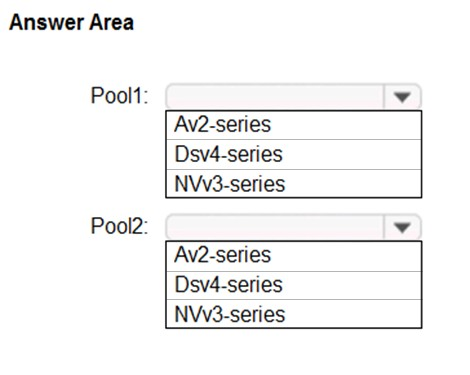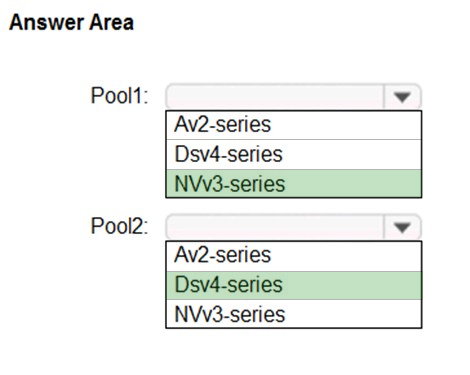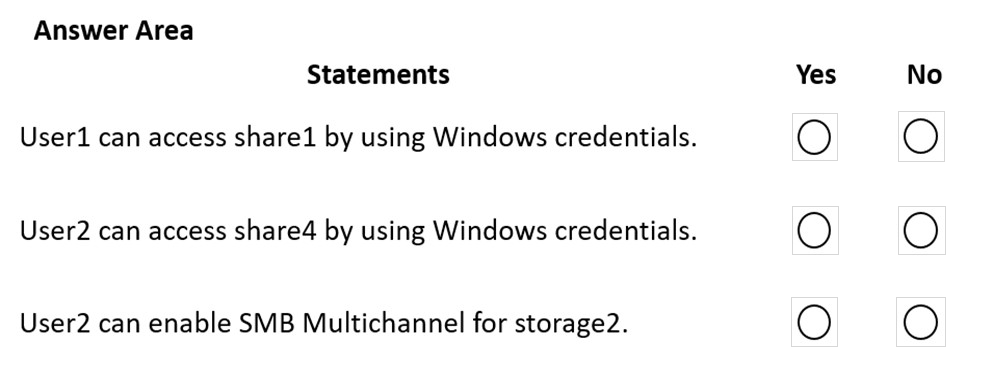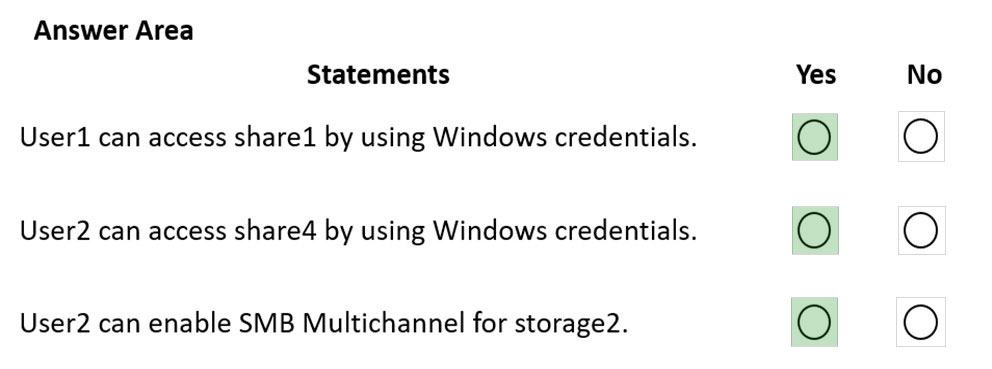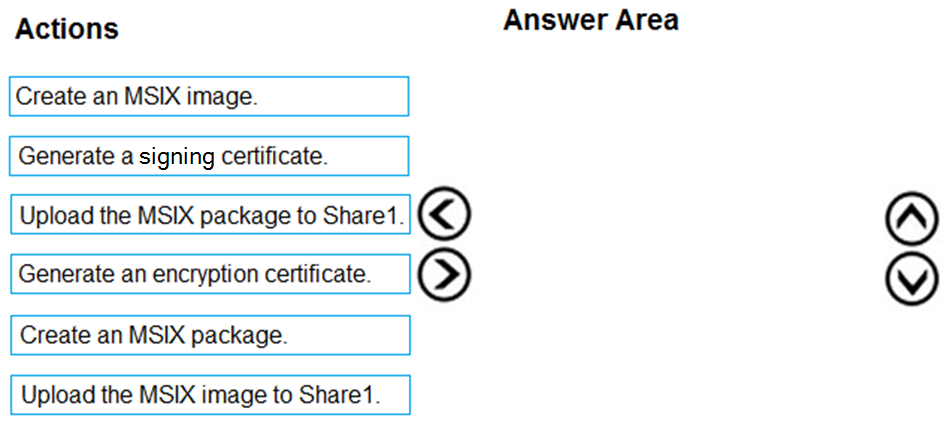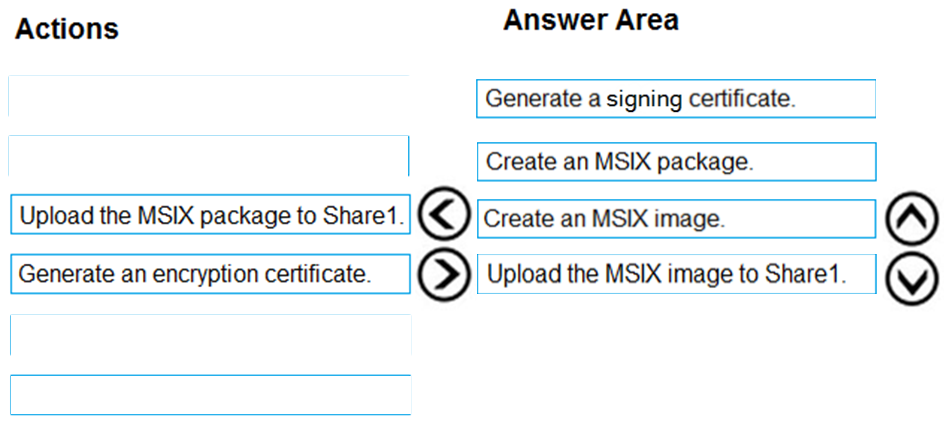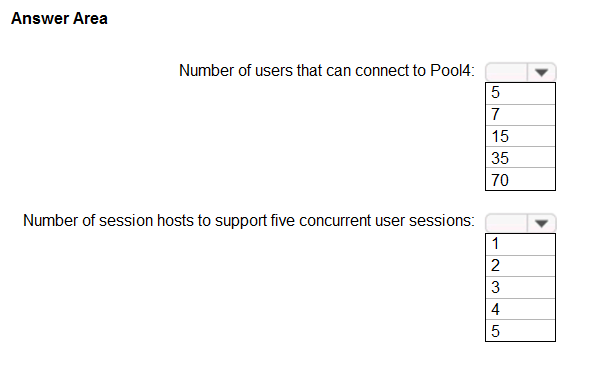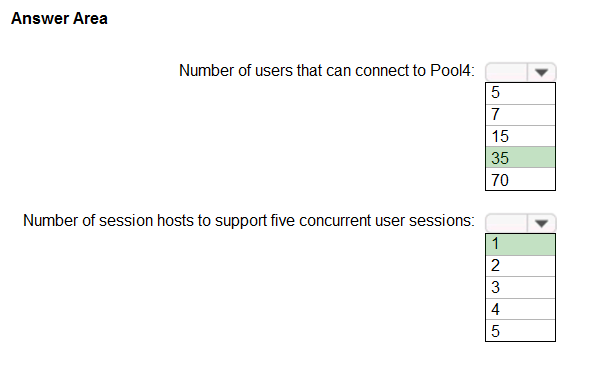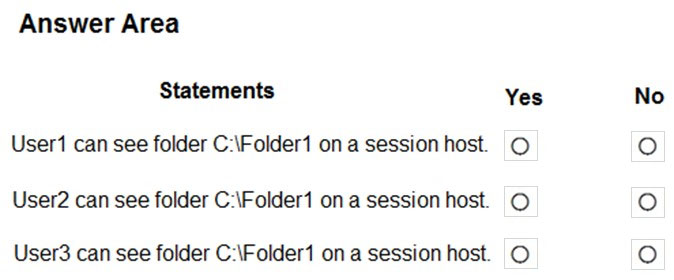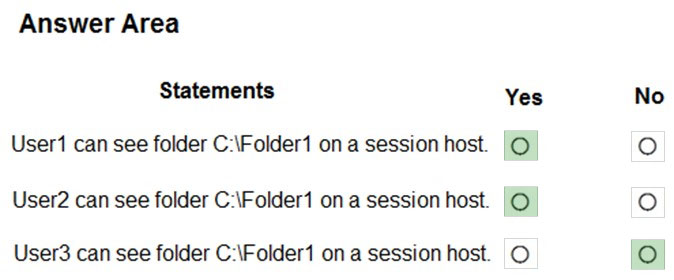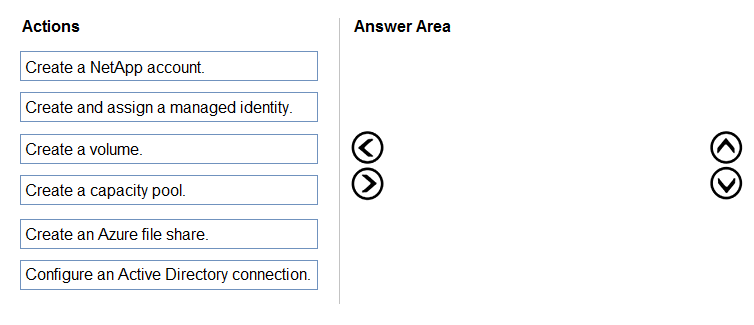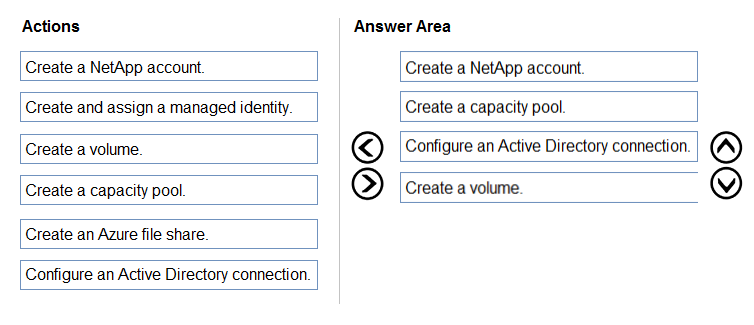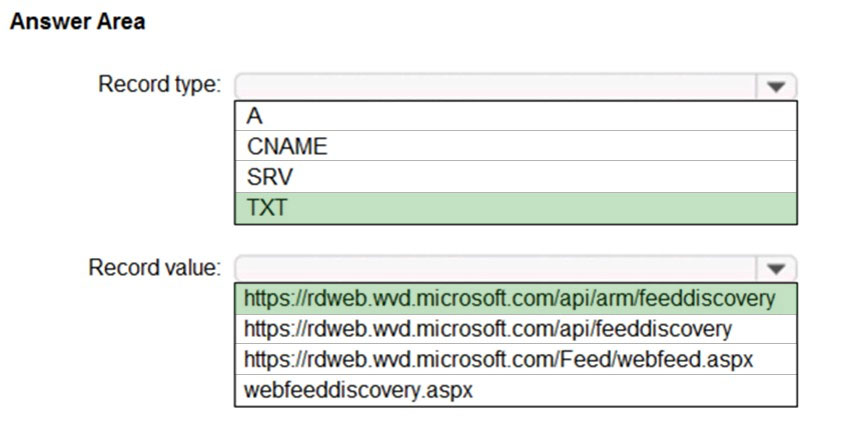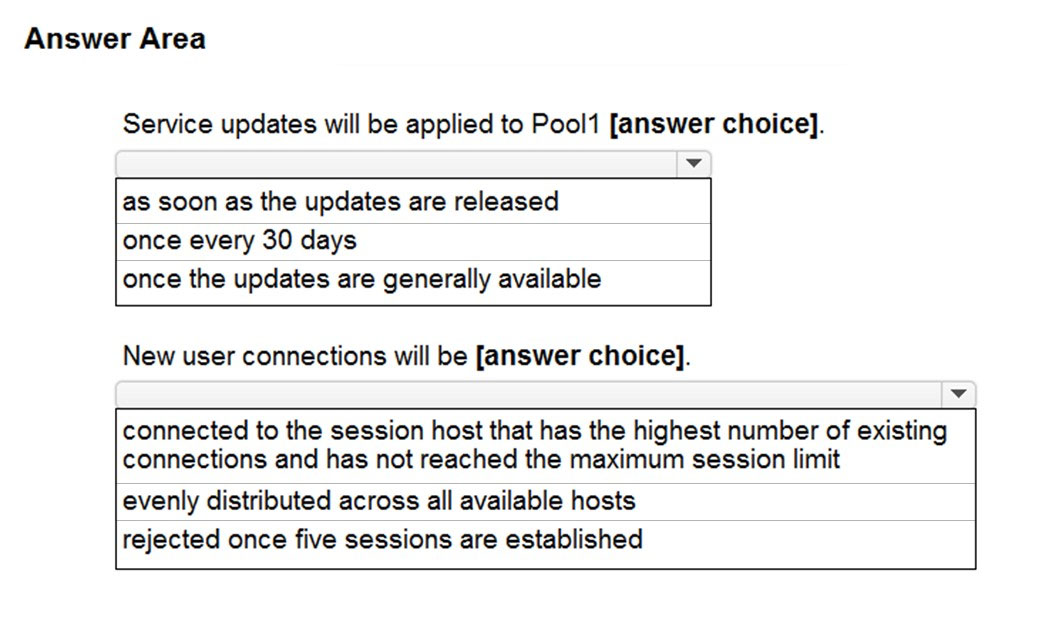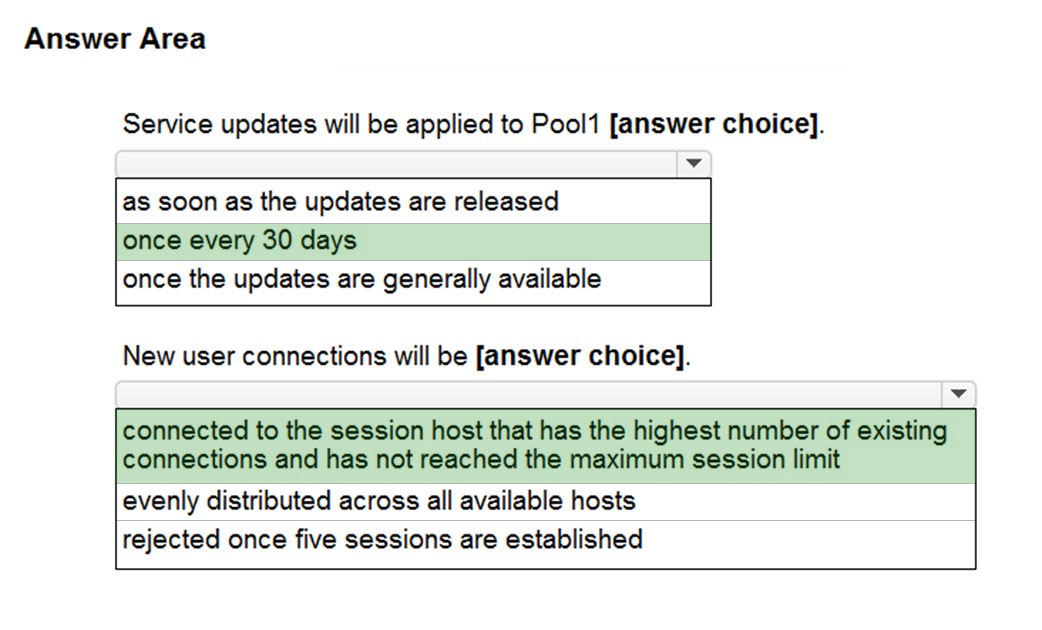AZ-140 Practice Exam Free – 50 Questions to Simulate the Real Exam
Are you getting ready for the AZ-140 certification? Take your preparation to the next level with our AZ-140 Practice Exam Free – a carefully designed set of 50 realistic exam-style questions to help you evaluate your knowledge and boost your confidence.
Using a AZ-140 practice exam free is one of the best ways to:
- Experience the format and difficulty of the real exam
- Identify your strengths and focus on weak areas
- Improve your test-taking speed and accuracy
Below, you will find 50 realistic AZ-140 practice exam free questions covering key exam topics. Each question reflects the structure and challenge of the actual exam.
You deploy an Azure Virtual Desktop host pool named Pool1. You have an Azure Storage account named store1 that stores FSLogix profile containers in a share named profiles. You need to configure the path to the storage containers for the session hosts. Which path should you use?
A. store1.blob.core.windows.netprofiles
B. https://store1.file.core.windows.net/profiles
C. store1.file.core.windows.netprofiles
D. https://store1.blob.core.windows.net/profiles
Overview - Contoso, Ltd. is a law firm that has a main office in Montreal and branch offices in Paris and Seattle. The Seattle branch office opened recently. Contoso has an Azure subscription and uses Microsoft 365. Existing Infrastructure. Active Directory The network contains an on-premises Active Directory domain named contoso.com and an Azure Active Directory (Azure AD) tenant. One of the domain controllers runs as an Azure virtual machine and connects to a virtual network named VNET1. All internal name resolution is provided by DNS server that run on the domain controllers. The on-premises Active Directory domain contains the organizational units (OUs) shown in the following table.The on-premises Active Directory domain contains the users shown in the following table.
The Azure AD tenant contains the cloud-only users shown in the following table.
Existing Infrastructure. Network Infrastructure All the Azure virtual networks are peered. The on-premises network connects to the virtual networks. A virtual network named VNET4 was recently created are peered to the other virtual networks. VNET4 does NOT contain any AVD virtual machines. All servers run Windows Server 2019. All laptops and desktop computers run Windows 10 Enterprise. Since users often work on confidential documents, all the users use their computer as a client for connecting to Remote Desktop Services (RDS). In the West US Azure region, you have the storage accounts shown in the following table.
Existing Infrastructure. Remote Desktop Infrastructure Contoso has a Remote Desktop infrastructure shown in the following table.
Requirements. Planned Changes - Contoso plans to implement the following changes: • Implement FSLogix profile containers for the Paris offices. • Deploy an Azure Virtual Desktop host pool named Pool4. • Migrate the RDS deployment in the Seattle office to Azure Virtual Desktop in the West US Azure region. Requirements. Pool4 Configuration Pool4 will have the following settings: • Host pool type: Pooled • Max session limit: 7 • Load balancing algorithm: Depth-first • Images: Windows 10 Enterprise multi-session • Virtual machine size: Standard D2s v3 • Name prefix: Pool4 • Number of VMs: 5 • Virtual network: VNET4 Requirements. Technical Requirements Contoso identifies the following technical requirements: • Before migrating the RDS deployment in the Seattle office, obtain the recommended deployment configuration based on the current RDS utilization. • For the Azure Virtual Desktop deployment in the Montreal office, disable audio output in the device redirection settings. • For the Azure Virtual Desktop deployment in the Seattle office, store the FSLogix profile containers in Azure Storage. • Enable Operator2 to modify the RDP Properties of the Azure Virtual Desktop deployment in the Montreal office. • From a server named Server1, convert the user profile disks to the FSLogix profile containers. • Ensure that the Pool1 virtual machines only run during business hours. • Use the principle of least privilege. You need to configure the virtual machines that have the Pool1 prefix. The solution must meet the technical requirements. What should you use?
A. an Azure Virtual Desktop automation task
B. Access control (IAM)
C. Service Health in Azure Monitor
D. Azure Automation
You need to recommend an authentication solution that meets the performance requirements. Which two actions should you include in the recommendation? Each correct answer presents part of the solution. NOTE: Each correct selection is worth one point.
A. Configure identity for all the session hosts.
B. In each Azure region that will contain the Azure Virtual Desktop session hosts, create an Azure Active Directory Domain Service (Azure AD DS) managed domain.
C. Deploy domain controllers for the on-premises Active Directory domain on Azure virtual machines to the new sites.
D. Deploy read-only domain controllers (RODCs) on Azure virtual machines to the new sites.
E. In each Azure region that will contain the Azure Virtual Desktop session hosts, create an Active Directory site.
After you answer a question in this section, you will NOT be able to return to it. As a result, these questions will not appear in the review screen. You have an Azure Virtual Desktop host pool that contains five session hosts. The session hosts run Windows 10 Enterprise multi-session. You need to prevent users from accessing the internet from Azure Virtual Desktop sessions. The session hosts must be allowed to access all the required Microsoft services. Solution: You configure the Address space settings of the virtual network that contains the session hosts. Does this meet the goal?
A. Yes
B. No
HOTSPOT - You have an Azure subscription that contains the resources shown in the following table.You have a virtual machine named Server1 that runs Windows Server and is connected to VNet3. You need to deploy the Azure Virtual Desktop host pools shown in the following table.
The solution must meet the following requirements: • The session hosts in Pool1 must access Server1 via the Microsoft backbone network. • The session hosts in Pool2 must access storage1 via the Microsoft backbone network. What should you configure on the virtual networks? To answer, select the appropriate options in the answer area. NOTE: Each correct selection is worth one point.
You have an Azure Virtual Desktop personal host pool named Pool1 that contains 20 Azure AD-joined session hosts. You need to ensure that only approved virtual machine extensions are installed on the Pool 1 session hosts. The solution must minimize administrative effort. What should you use?
A. Azure Resource Manager (ARM) templates
B. Azure Policy
C. Windows Admin Center
D. Group Policy
HOTSPOT - You have an Azure Virtual Desktop deployment. You plan to create the host pools shown in the following table.You need to recommend the virtual machine size for each host pool. The solution must minimize costs. Which size should you recommend for each pool? To answer, select the appropriate options in the answer area. NOTE: Each correct selection is worth one point. Hot Area:
HOTSPOT - You have an Azure Virtual Desktop deployment that contains two users named User1 and User2 and the storage accounts shown in the following table.The File share settings for storage1 are configured as shown in the following exhibit.
The File share settings for storage2 are configured as shown in the following exhibit.
For each of the following statements, select Yes if the statement is true. Otherwise, select No. NOTE: Each correct selection is worth one point. Hot Area:
Your network contains an on-premises Active Directory domain that syncs to an Azure Active Directory (Azure AD) tenant. The domain contains the domain controllers shown in the following table.The DNS servers are configured to forward requests to an external DNS service. You create a new virtual network named VNET2 that is peered to VNET1 and has gateway transit enabled. You plan to implement an Azure Virtual Desktop host pool in VNET2. The session hosts will be joined to the Active Directory domain. You need to configure DNS to meet the following requirements: ✑ Ensure that Azure Virtual Desktop users can resolve on-premises servers and Azure resources. ✑ Ensure that azure Virtual Desktop remains operational if a DNS server fails. ✑ Minimize administrative effort. What should you configure?
A. the DNS settings of VNET2 to use Server2 and Server1
B. the DNS settings of VNET2 to use the Azure DNS service
C. the DNS settings of the virtual machines to use Server2 and Server1
D. the DNS settings of the virtual machines to use the Azure DNS service
You have an Azure storage account that contains the generalized Windows 10 disk images shown in the following table.You need to create an image that will be used to deploy an Azure Virtual Desktop session host. Which disk should you use?
A. Disk1
B. Disk2
C. Disk3
D. Disk4
HOTSPOT - You have an Azure subscription named Subscription1 that contains the users shown in the following table.Subscription1 contains the Azure Virtual Desktop host pools shown in the following table.
Subscription1 contains the Azure Virtual Desktop application groups shown in the following table.
You perform the role assignments shown in the following table.
For each of the following statements, select Yes if the statement is true. Otherwise, select No. NOTE: Each correct selection is worth one point. Hot Area:
You have an Azure AD tenant that contains a resource group named RG1. RG1 contains the resources shown in the following table.Your on-premises network has an IP address range of 192.168.10.0/24. Users on Host1 can successfully connect to the resources on the network. You add a new on-premises network that has an IP address range of 192.168.11.0/24 and contains a subnet. The subnet contains an application server named App1. Users report that Host1 cannot connect to App1. You need to ensure that the users on Host1 can access App1. What should you modify?
A. the Connections settings of VPNGW1
B. the Subnets setting of VNet1
C. the Configuration settings of LNGW1
D. the DNS server settings of VNet1
E. the RDP Properties of the host pool
You have an Azure Active Directory (Azure AD) tenant named contoso.com. You use a user account named Admin1 to deploy an Azure Active Directory Domain Services (Azure AD DS) managed domain named aaddscontoso.com to a virtual network named VNET1. You plan to deploy an Azure Virtual Desktop host pool named Pool1 to VNET1. You need to ensure that you can use the Admin1 user account to deploy Windows 10 Enterprise session hosts to Pool1. What should you do first?
A. Add Admin1 to the AAD DC Administrators group of contoso.com.
B. Assign the Cloud device administrator role to Admin1.
C. Assign a Microsoft 365 Enterprise E3 license to Admin1.
D. Change the password of Admin1.
HOTSPOT - You have an Azure Virtual Desktop deployment that contains the session hosts shown in the following table.You have the users shows in the following table.
Users connect to Azure from the locations shown in the following table.
For each of the following statements, select Yes if the statement is true. Otherwise, select No. NOTE: Each correct selection is worth one point.
You need to implement network security to meet the security requirements and the performance requirements. Which two actions should you perform? Each correct answer presents a complete solution. NOTE: Each correct selection is worth one point.
A. Deploy two Azure Firewall instances and Azure Firewall Manager.
B. Filter traffic by using outbound rules.
C. Filter traffic by using infrastructure rules.
D. Filter traffic by using inbound rules.
E. Deploy a network security group (NSG) and two application security groups.
F. Deploy an Azure Firewall instance and Azure Firewall Manager.
DRAG DROP - You have an Azure Virtual Desktop host pool named Pool1, an application named App1, and an Azure file share named Share1. You need to ensure that you can publish App1 to Pool1 by using MSIX app attach. Which four actions should you perform in sequence before you publish App1? To answer, move the appropriate actions from the list of actions to the answer area and arrange them in the correct order. Select and Place:
You need to deploy the session hosts to meet the deployment requirements. Which PowerShell cmdlet should you run first?
A. Update-AzWvdSessionHost
B. Get-AzApiManagementSsoToken
C. Set-AzVMADDomainExtension
D. New-AzWvdRegistrationInfo
HOTSPOT - You are planning the deployment of Pool4. What will be the maximum number of users that can connect to Pool4, and how many session hosts are needed to support five concurrent user sessions? To answer, select the appropriate options in the answer area. NOTE: Each correct selection is worth one point. Hot Area:
HOTSPOT - You have a hybrid Azure Active Directory (Azure AD) tenant named contoso.com that contains the users shown in the following table.You have an Azure Virtual Desktop host pool. All the session hosts have a folder named C:Folder1. You create an FSLogix Application Masking rule as shown in the following exhibit.
You create assignments for the Application Masking rule as shown in the following exhibit.
For each of the following statements, select Yes if the statement is true. Otherwise, select No. NOTE: Each correct selection is worth one point. Hot Area:
HOTSPOT - You have an Azure Virtual Desktop deployment that contains the resources shown in the following table.You create the resources shown in the following table.
You need to meet following requirements: • Back up the FSLogix profile containers used by HostPool1. • Backup the data disks in HostPool2. To which resources can you back up the profile containers and the data disks? To answer, select the appropriate options in the answer area. NOTE: Each correct selection is worth one point.
You have an Azure Virtual Desktop deployment. You deploy and configure Azure Virtual Desktop in a secondary location. You plan to perform a test failover to the secondary location, but discover existing user sessions to the primary location. You need to sign out users from the session hosts in the primary location. Which PowerShell cmdlet should you run?
A. Invoke-RdsUserSessionLogoff
B. Remove-AzWvdUserSession
C. Invoke-RestMethod
D. Remove-Alias
HOTSPOT - You have an Azure Virtual Desktop host pool named HostPool1 that must support 60 sessions. The session hosts for HostPool1 are configured as shown in the following exhibit.Use the drop-down menus to select the answer choice that completes each statement based on the information presented in the graphic. NOTE: Each correct selection is worth one point.
You have an Azure Virtual Desktop host pool named Pool1. You are troubleshooting an issue for a Remote Desktop client that stopped responding. You need to restore the default Remote Desktop client settings and unsubscribe from all workspaces. Which command should you run?
A. msrdcw
B. resetengine
C. mstsc
D. resetpluginhost
DRAG DROP - You plan to deploy Azure Virtual Desktop. You need to create Azure NetApp Files storage to store FSLogix profile containers. Which four actions should you perform in sequence after you register the NetApp Resource Provider? To answer, move the appropriate actions from the list of actions to the answer area and arrange them in the correct order. NOTE: More than one order of answer choices is correct. You will receive credit for any of the correct orders you select. Select and Place:
After you answer a question in this section, you will NOT be able to return to it. As a result, these questions will not appear in the review screen. You have the following: ✑ A Microsoft 365 E5 tenant ✑ An on-premises Active Directory domain ✑ A hybrid Azure Active Directory (Azure AD) tenant ✑ An Azure Active Directory Domain Services (Azure AD DS) managed domain An Azure Virtual Desktop deploymentThe Azure Virtual Desktop deployment contains personal desktops that are hybrid joined to the on-premises domain and enrolled in Microsoft Intune. You need to configure the security settings for the Microsoft Edge browsers on the personal desktops. Solution: You configure a compliance policy in Intune. Does this meet the goal?
A. Yes
B. No
You create the virtual machines shown in the following table.You need a source virtual hard disk for new Azure Virtual Desktop session host deployments. The source operating system must have user-specific and machine- specific information removed. Which virtual machines can you use as the source?
A. SourceVM3 only
B. SourceVM1 only
C. SourceVM1, SourceVM2, and SourceVM3
D. SourceVM1 and SourceVM2 only
E. SourceVM2 only
You have an Azure Virtual Desktop host pool in the East US region. You need to implement a disaster recovery solution that meets the following requirements: ✑ If users cannot connect to the Azure Virtual Desktop resources in the East US region, the users must be able to connect to the equivalent resources in the West US region. ✑ Users must connect to the Azure Virtual Desktop resources in either the East US or the West US region by selecting a single icon in the Remote Desktop clientׁ ✑ In the event of a disaster, failover between the Azure regions must be initiated manually by an administrator. ✑ Failover times must be minimized. What should you do?
A. Configure a shared image gallery that has replicas in the East US and West US regions
B. Create new session hosts in the West US region and add the session hosts to an existing host pool
C. Create an additional host pool in the West US region
D. Enable Azure Site Recovery replication of the virtual machines to the West US region
E. Enable Azure Backup to a Recovery Services vault in the West US region
You have an Azure Virtual Desktop host pool named Pool1 that contains three session hosts. The session hosts are configured to use FSLogix profile containers. You need to configure Cloud Cache on the session hosts. What should you do?
A. Add a VHDLocations entries to the Windows registry
B. Remove VHDLocations entries from the Windows registry
C. Uninstall the FSLogix agent
D. Configure FSLogix Office Container
HOTSPOT - You have an Azure Virtual Desktop deployment. Many users have iOS devices that have the Remote Desktop Mobile app installed. You need to ensure that the users can connect to the feed URL by using email discovery instead of entering the feed URL manually. How should you configure the _msradc DNS record? To answer, select the appropriate options in the answer area. NOTE: Each correct selection is worth one point. Hot Area:
HOTSPOT - You have an Azure Virtual Desktop Deployment that contains a workspace named Workspace1 and a user named User1. Workspace1 contains a Desktop application group named Pool1Desktop. At 09:00, you create a conditional access policy that has the following settings: ✑ Assignments: - Users and groups: User1 - Cloud apps or actions: Azure Virtual Desktop - Conditions: 0 conditions selected ✑ Access controls - Grant: Grant access, Require multi-factor authentication - Sessions: Sign-in frequency 1 hour User1 performs the actions shown in the following table.For each of the following statements, select Yes if the statement is true. Otherwise, select No. NOTE: Each correct selection is worth one point. Hot Area:
You have an Azure Virtual Desktop deployment. You plan to use FSLogix profile containers. You need to recommend a solution that will be used to store the containers. The solution must meet the following requirements: * The containers must be stored on solid-state drives (SSDs) * Minimize administrative effort * Minimize cost What should you recommend?
A. Azure NetApp Files
B. Azure Files Standard
C. Azure Blob Storage Premium
D. Azure Files Premium
DRAG DROP - You have an Azure Virtual Desktop host pool named Pool1. Pool1 contains session hosts that use FSLogix profile containers hosted in Azure NetApp Files volumes. You need to back up profile files by using snapshots. Which three actions should you perform in sequence? To answer, move the appropriate actions from the list of actions to the answer area and arrange them in the correct order. Select and Place:
You plan to deploy Azure Virtual Desktop. The deployment will use existing virtual machines. You create a Azure Virtual Desktop host pool. You need to ensure that you can add the virtual machines to the host pool. What should you do first?
A. Register the Microsoft.DesktopVirtualization provider.
B. Generate a registration key.
C. Run the Invoke-AzVMRunCommand cmdlet.
D. Create a role assignment.
You network contains an on-premises Active Directory domain. The domain contains a universal security group named AVDusers. You have a hybrid Azure Active Directory (Azure AD) tenant. AVDusers syncs to Azure AD. You have an Azure Virtual Desktop host pool that contains four Windows 10 Enterprise multi-session hosts. You need to ensure that only the members of AVDusers can establish Azure Virtual Desktop sessions to the host pool. What should you do?
A. Assign AVDusers to an Azure role scoped to each host pool.
B. On each session host, add AVDusers to the local Remote Desktop Users group.
C. Assign AVDusers to an Azure role scoped to the session hosts.
D. Assign AVDusers to an application group.
HOTSPOT - You have an Azure Virtual Desktop deployment that contains a host pool named HostPool1. You need to perform the following configurations for HostPool1: • Set the scale factor of the remote session to 125 percent. • Generate a registration key that expires after five days. • Enable Start VM on connect. Which three settings should you modify? To answer, select the appropriate settings in the answer area. NOTE: Each correct selection is worth one point.
After you answer a question in this section, you will NOT be able to return to it. As a result, these questions will not appear in the review screen. You have an Azure Virtual Desktop host pool that contains five session hosts. The session hosts run Windows 10 Enterprise multi-session. You need to prevent users from accessing the internet from Azure Virtual Desktop sessions. The session hosts must be allowed to access all the required Microsoft services. Solution: You configure the RDP Properties of the host pool. Does this meet the goal?
A. Yes
B. No
Which two roles should you assign to Admin2 to meet the security requirements? Each correct answer presents part of the solution. NOTE: Each correct selection is worth one point.
A. Desktop Virtualization Host Pool Contributor
B. Desktop Virtualization Application Group Contributor
C. Desktop Virtualization Workspace Contributor
D. Desktop Virtualization Application Group Reader
E. User Access Administrator
Your network contains an on-premises Active Directory domain and an Azure Virtual Desktop deployment. The computer accounts for all the session hosts are in an organizational unit (OU) named WVDHostsOU. All user accounts are in an OU named CorpUsers. A domain administrator creates a Group Policy Object (GPO) named Policy1 that only contains user settings. The administrator links Policy1 to WVDHostsOU. You discover that when users sign in to the session hosts, none of the settings from Policy1 are applied. What should you configure to apply GPO settings to the users when they sign in to the session hosts?
A. loopback processing
B. FSLogix profiles
C. mandatory Roaming User Profiles
D. restricted groups
You have an Azure Virtual Desktop deployment that uses Azure Active Directory Domain Services (Azure AD DS). You have the following host pool: • Name: Pool1 • Type: Personal • Number of session hosts: 5 You plan to deploy two new session hosts to Pool1. What should you do before you deploy the session hosts?
A. Create a scaling plan.
B. Precreate a computer account in Azure AD DS.
C. Increase the maximum session limit.
D. Create a registration key.
You have an Azure Virtual Desktop deployment that contains the host pools shown in the following table.You need to create a disaster recovery environment in the West US region. The solution must minimize costs and administrative effort. What should you do?
A. Regenerate the token and reregister the virtual machines in the host pools.
B. Create two new host pools in the West US region.
C. Run the Invoke-RdsUserSessionLogoff cmdlet.
D. Create an Azure Site Recovery plan.
HOTSPOT - You have an Azure virtual machine named VM1 that runs Windows 10 Enterprise multi-session. You plan to add language packs to VM1 and create a custom image of VM1 for an Azure Virtual Desktop host pool. You need to ensure that modern apps can use the additional language packs when you deploy session hosts by using the custom image. Which command should you run first? To answer, select the appropriate options in the answer area. NOTE: Each correct selection is worth one point. Hot Area:
You plan to deploy Azure Virtual Desktop to meet the department requirements shown in the following table.You plan to use Azure Virtual Desktop host pools with load balancing and autoscaling. You need to recommend a host pool design that meets the requirements. The solution must minimize costs. What is the minimum number of host pools you should recommend?
A. 1
B. 2
C. 3
D. 4
HOTSPOT - You have an Azure Virtual Desktop deployment that contains a host pool named Pool1. Pool1 contains two session hosts. Pool1 is configured as shown in the following exhibit.Use the drop-down menus to select the answer choice that completes each statement based on the information presented in the graphic. NOTE: Each correct selection is worth one point. Hot Area:
HOTSPOT - You have an Azure subscription that contains the storage accounts shown in the following table.The subscription contains the vaults shown in the following table.
The subscription contains the Azure Virtual Desktop host pools shown in the following table.
For each of the following statements, select Yes if the statement is true. Otherwise, select No. NOTE: Each correct selection is worth one point.
You have an Azure Virtual Desktop host pool named Pool1 and an Azure Storage account named Storage1. Storage1 stores FSLogix profile containers in a share folder named share1. You create a new group named Group1. You provide Group1 with permission to sign in to Pool1. You need to ensure that the members of Group1 can store the FSLogix profile containers in share1. The solution must use the principle of least privilege. Which two privileges should you assign to Group1? Each correct answer presents part of the solution. NOTE: Each correct selection is worth one point.
A. the Storage Blob Data Contributor role for storage1
B. the List folder / read data NTFS permissions for share1
C. the Modify NTFS permissions for share1
D. the Storage File Data SMB Share Reader role for storage1
E. the Storage File Data SMB Share Elevated Contributor role for storage1
F. the Storage File Data SMB Share Contributor role for storage1
Your network contains an on-premises Active Directory domain named contoso.com that syncs to an Azure Active Directory (Azure AD) tenant. You have an Azure Virtual Desktop host pool named Pool1 that has the following settings: * Host pool name: Pool1 * Host pool type: Personal * Number of VMs: 3 The session hosts have the following configurations: * Image used to create the virtual machines: Windows 10 Enterprise8 * Virtual machines domain-joined to: On-premises contoso.com domain You need to ensure that you can use Microsoft EndPoint Manager to manage security updates on the session hosts. What should you do?
A. Change Host pool type to Pooled and specify Load balancing algorithm as Depth-first.
B. Change Host pool type to Pooled and specify Load balancing algorithm as Breadth-first.
C. Create Windows 10 Enterprise multi-session images.
D. Configure the session hosts as hybrid Azure AD-joined.
DRAG DROP - You need to ensure that you can implement user profile shares for the Boston office users. The solution must meet the user profile requirements. Which four actions should you perform in sequence? To answer, move the appropriate actions from the list of actions to the answer area and arrange them in the correct order. Select and Place:
You have an Azure subscription that contains 500 users. The users are assigned Microsoft Office 365 E1 licenses. You deploy an Azure Virtual Desktop solution that contains Windows 10 multi-session hosts and streams a custom remote app named App1. You need to ensure that the users are licensed to stream App1. The solution must minimize costs. Which license should you use?
A. Microsoft 365 E5
B. Office 365 E3
C. a Remote Desktop Services (RDS) client access license (CAL)
D. Windows 10 Enterprise E3
You have an Azure Virtual Desktop deployment that contains a host pool named Pool1. Pool1 contains a session host named Host1 that is Azure AD-joined. You need to verify whether a Windows license is assigned to Host1. What should you do?
A. From the Azure Active Directory admin center, view the product licenses.
B. From VM1, run the Get-WindowsDeveloperLicense cmdlet.
C. From the Azure portal, view the properties of Host1.
D. From Azure Cloud Shell, run the Get-AzVm cmdlet.
You have an Azure Virtual Desktop deployment that contains a session host named Host1. You need to configure Windows Defender Firewall to allow inbound network traffic for RDP Shortpath on Host1. Which program in the C:WindowsSystem32 folder should you specify in the inbound firewall rule?
A. Rdpshell.exe
B. Svchost.exe
C. Raserver.exe
D. Mstsc.exe
Free Access Full AZ-140 Practice Exam Free
Looking for additional practice? Click here to access a full set of AZ-140 practice exam free questions and continue building your skills across all exam domains.
Our question sets are updated regularly to ensure they stay aligned with the latest exam objectives—so be sure to visit often!
Good luck with your AZ-140 certification journey!




